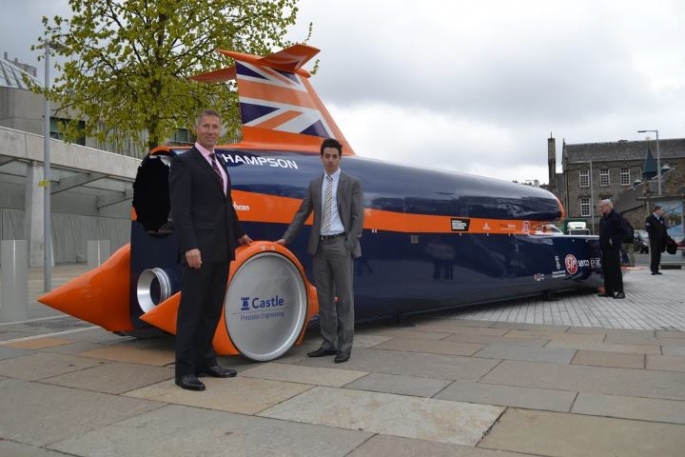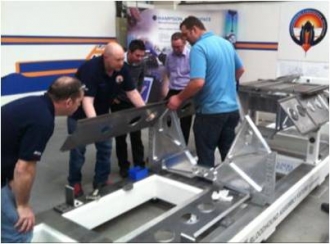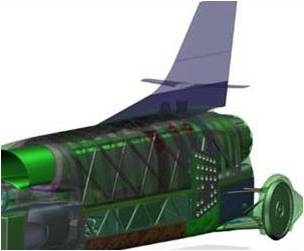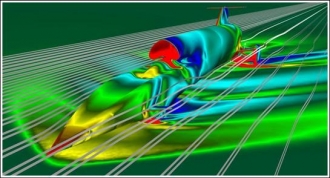
In last month’s BLOODHOUND diary I outlined the various methods we have for stopping the world’s first 1000 mph Car – airbrakes, drag parachutes and wheel brakes. We’ve had a lot of feedback since then, mostly on the airbrake mechanism – including: how we are going to balance the two hydraulic rams, so that they work together?
The answer is very simple – the pistons are bolted together at the ends, so that they move as one. Having two pistons gives us an added layer of safety, in case one of the systems develops a leak – and having all the feedback last month means that we’re not likely to miss anything important, because someone out there will point it out to us!
 Precision Engineering for pilots
Precision Engineering for pilots
I was doing an interview this week by phone with a US journalist, and he asked if was worried about the huge forces and loads involved in travelling at 1000 mph, particularly on the wheels. I can see why he asked – the wheels will be doing 177 turns every second, subjecting the wheel rims to some 50,000 ‘G’.
Clearly a failure at this speed would be catastrophic, so the wheels need to be perfect – and here we’ve got some great news. We’ve just announced a terrific sponsorship deal with Castle Precision Engineering, based in Glasgow, who are going to make all of the Car’s wheels. Castle makes jet engine fan disks, among many other things – as a Royal Air Force fighter pilot, this is the sort of technology I can relate to.
The press launch was outside the Scottish Parliament building in Edinburgh – a great place to announce our first major Scottish sponsor (despite the cold and the rain…). This level of support is great news for the Project – one less thing to worry about. See the picture at the top of this page with Jan Tiefenbrun (left) from Castle Engineering – my new best friend!
Back to that US journalist’s question – am I worried? With companies like Lockheed Martin (UK) doing the wheel design, and world-class experts like Castle building them, BLOODHOUND is getting the very best of technology and I can have a lot of confidence in it – so no, I’m not worried. We know that this is going to work.
 Lower Chassis Assembly
Lower Chassis Assembly
The manufacture of the lower rear chassis is coming on well, with Hampson Engineering now starting to assemble the various components up in Wigan. This part of the Car will have to take all of the thrust load from the rocket (up to 12 tonnes of thrust) as well as the huge suspension loads, so it needs to be done right.
The upper chassis is proving slightly more challenging. To keep the weight down, we are planning to use titanium panels, but bending them is proving difficult. Titanium is very susceptible to surface cracking if there are any surface defects – so far we’ve bent 3 test panels and cracked one.
 A cracking challenge
A cracking challenge
We’re taking some specialist advice and looking for some different titanium alloys, which is the quick way to solve the problem. If these other titanium alloys prove hard to source, then we can look at other metals, such as aluminium or steel. However, aluminium expands much faster than steel, so the chassis would try to bend in the desert sun (not a good characteristic) and steel is heavier, and we are trying to avoid adding any more weight to the Car – so let’s hope that we can find the right grade of titanium.
Meanwhile, our design team down in Bristol is working hard to provide Hyde Engineering with details of the aerodynamic loads on the fin, so that they can complete the design and start to build it. Once complete, the Fin will provide the aerodynamic force to give the Car a ‘positive yaw static margin’ – in other words, it will keep the Car pointy-end forwards at high speed. We’ve now got over 11,000 names on the tail fin – but there’s still room for you to add your name and have it travel at 1000 mph!
 More good news from the aero team
More good news from the aero team
The aerodynamic design work keeps going, as we learn more about the performance of the Car’s final shape. One piece of good news that came out this month was the aerodynamic response to ride height changes – in other words, what happens if the Car meets a small rise or dip on the desert surface. The design ride height for BLOODHOUND SSC is currently 130 mm, from the Car’s underside to the desert floor. If the Car rises up by 30 mm (perhaps due to changes in the desert surface, or the loads on the Car), then the downforce on the body will increase by about 1000 kg, pushing the Car gently back down again. This is a stabilising aerodynamic force, which we expected it would be, but the confirmation is very good news.
Finally, surprising fact of the month comes from our website which continues to run up to 10,000 pages a day, with nearly every country in the world following us (we haven’t cracked Vanuatu yet, but we’re working on it). The surprise? While you’d expect to hear that the UK and the US are our 2 biggest audiences, guess where our third biggest following was last month? Slovenia. So if you’re from Slovenia and coming to the UK this summer, then please come and see us at one of the BLOODHOUND public events – we’d love to say thank you for your support. And if you’re not from Slovenia – come and see us anyway!





